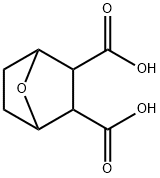Chemical Properties
Endothall, when pure, is a white crystalline
solid. The technical grade is a light brown liquid
Uses
Preemergence and postemergence herbicide for control of broad-leaved weeds and
annual grass in vegetable crops. The disodium and dipotassium salts are used as defoliants
and herbicides.
Uses
Defoliant, herbicide.
Uses
Endothall is used as an inhibitor of PP2A phosphatase activity. It is also used as a defoliant. It is used as a cell adhesion inhibitor.
General Description
The monohydrate is in the form of colorless crystals. Non corrosive. Used as a selective herbicide.
Air & Water Reactions
Stable up to 90°C, above which ENDOTHAL undergoes slow hydrolysis.
Reactivity Profile
A phthalic acid derivative.
Hazard
Strong irritant to eyes and skin.
Agricultural Uses
Herbicide, Algaecide: Endothall is used as a cotton defoliant and as a selective
contact herbicide on both terrestrial and aquatic
weeds. The potassium and amine salts of endothall are
used as aquatic herbicides to control a variety of plants
including plankton, pondweed, niad, coontail, milfoil, elodea,
and algaes in water bodies and rice fields. Endothall
is also used to control annual grass and broadleaf weeds
in sugar beets, spinach and turf. It reduces sucker branch
growth in hops. Endothall is a desiccant to aid the harvest
of alfalfa, potatoes, clover, and cotton. Not approved for
use in EU countries. Approved for use in the U.S. and
other countries. There are 24 global suppliers.
Trade name
ACCELERATE®; AQUATHOL®;
DES-I-CATE®; HYDOUT®; HYDROTHAL-47®;
HYDROTHOL®; NIAGARATHOL®; RIPENTHOL®;
TRI-ENDOTHAL®
Safety Profile
Poison by ingestion.
Very irritating to skin, eyes, and mucous
membranes. Causes dlarrhea. When heatedto decomposition it emits acrid smoke and
fumes
Potential Exposure
Endothall is dicarboxylic acid defoliant and herbicide used on both terrestrial and aquatic
weeds.
First aid
If this chemical gets into the eyes, remove anycontact lenses at once and irrigate immediately for at least
Environmental Fate
Biological. Incubation of 14C-ring labeled endothall (10 mg/mL) by Arthrobacter sp.,
which was isolated from pond water and a hydrosol, in aerobic sediment-water suspensions
revealed that after 30 days, 40% evolved as 14CO2. Glutamic acid was the major transformation
product. Minor products were alanine, citric and aspartic acids and unidentified
products, some of which were tentatively identified as phosphate esters (Sikka and Saxena,
1973). In pond water treated with endothall (2 and 4 ppm), detectable levels were found
after 7 days (Sikka and Rice, 1973). Biodegradation was rapid in an Ontario soil sample.
After 1 week, 70% of endothall added was converted to carbon dioxide (Simsiman et al.,
1976).
Chemical/Physical. Reacts with bases forming water-soluble salts. Above 90°C, endothall
is slowly converted to the anhydride (Windholz et al., 1983; Hartley and Kidd, 1987)
and water (Humburg et al., 1989). Endothall is stable to light (Hartley and Kidd, 1987).
Shipping
UN2811 Toxic solids, organic, n.o.s., Hazard
Class: 6.1; Labels: 6.1-Poisonous materials, Technical Name
Required. UN2588 Pesticides, solid, toxic, Hazard Class: 6.1;
Labels: 6.1-Poisonous materials, Technical Name Required.
Incompatibilities
Compounds of the carboxyl group react
with all bases, both inorganic and organic (i.e., amines)
releasing substantial heat, water and a salt that may be
harmful. Incompatible with arsenic compounds (releases
hydrogen cyanide gas), diazo compounds, dithiocarbamates,
isocyanates, mercaptans, nitrides, and sulfides (releasing
heat, toxic, and possibly flammable gases), thiosulfates and
dithionites (releasing hydrogen sulfate and oxides of sulfur)
Toxics Screening Level
The Initial Threshold Screening Level (ITSL) for endothall of 70 μg/m3 with annual averaging time is being rescinded.
Waste Disposal
Small quantities may be disposed of by burial in soil which is rich in organic matter.
Large quantities are best disposed of by incineration.
Consult with environmental regulatory agencies for guidance on acceptable disposal practices. Generators of waste
containing this contaminant (5100 kg/mo) must conform
with EPA regulations governing storage, transportation,
treatment, and waste disposal. In accordance with
40CFR165, follow recommendations for the disposal of
pesticides and pesticide containers. Must be disposed properly by following package label directions or by contacting
your local or federal environmental control agency, or by
contacting your regional EPA office


